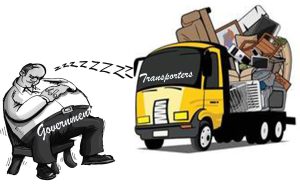[gravityform id=”1″ title=”false” description=”false” ajax=”true”]
Mashariki Television Networks Limited Email: info@themasharikinewspaper.com
Email Us
Our address
Mashariki Communications Centre
Meru-Maua Road
Main Telephone: +254 797 372 837
Postal Address: P. O. Box 747-60200, Meru, KenyaWe are social

Various places in the eastern region and the neighboring parts of the Rift Valley region have recently benefited from infrastructural projects in the form of roads and related areas.
The residents of these areas are currently enjoying the good things that come as a result of smooth roads in most areas where there used to be none.
They can now access their homes and trading areas with ease. The traffic has increased, and the social, and economic growth in these areas is evident.
This joy seems to be short-lived if the current trend of transporters breaking the law by carrying excess axle weight continues.
The roads are giving in to unbearable force and pressure exerted by the wheels of overloaded trucks.
There seems to have nobody caring for the infrastructure when it comes to matters of damaging the roads by the Lorries and trucks owned by selfish transporters who care less when it comes to road maintenance.
According to the law, the axle weight restrictions on the roads of East Africa are expected to be very strictly adhered to by the Government agencies to avoid potential damage to the roads.
The law that governs the axle weight is under section 114 (1) p of the Road Traffic Act, 1973, and the subsequent Government Notice No. 30, published on 9/2/2001.
These regulations apply to all vehicles of 3,500 Kg permissible weight or above. The highlights of the regulations include the overall allowed dimensions that are; Width of 2.6 meters, Height of 4.6 meters from the road surface, and length of a rigid vehicle of 12.5 meters.
The overall length of articulated vehicles is 17.0 meters, and the overall length of any combination of vehicles is 22.0 Meters.
It should be noted that the allowable axle weight is governed by the type of vehicle, and its axle configuration should be a total of the allowed Axle weight: 50,000 Kg. finally, the approximate tare weight of the truck/Trailer: is 22,000 Kg allowable payload. Is 28 tonnes. Any additional load on the axle shall attract an overload penalty to be payable to the government.
“A vehicle not only has to fall within the maximum gross weight limit but also none of its axles should weigh more than eight tonnes,” KeNHA director-general Meshack Kidenda recently.
However, a new law passed by the East African Legislative Assembly has set the stage for a fresh round of confrontation between stakeholders.
According to a report recently published by the People Daily, The Vehicle Load Control Bill 2012 passed on would raise the maximum gross vehicle weight on roads of member countries to 56 tons.
Currently, the maximum gross vehicle weight on Kenyan roads is 48 tonnes which was passed to protect Kenyan roads from rogue transporters responsible for damaging many Kenyan roads.
The existing Kenya law allows arrests and fining of truck drivers, including those that comply with its 48-tonne overall weight rule when the number of axles is exceeded.
Overloading on Kenyan roads currently attracts fines of up to Sh200, 000 on the first conviction and Sh400, 000 for repeat offenses.
Despite all these, Kenyans are witnessing gross misconduct of transporters of Lorries carrying excess weight on our roads.
They are damaging newly constructed roads as the government keeps a blind eye to the issue.
Where are the mobile weigh machines on roads in Meru, Tharaka Nithi, Isiolo, Embu, Kitui, Laikipia, Samburu, and Marsabit?
These areas have just started enjoying the new roads like the great northern road that serves Laikipia, Meru, Isiolo, Samburu, and Marsabit. The Kibwezi – Mutomo – Kitui road in Kitui County, and the Mati road that connects Embu to Tharaka and Meru.
The Isiolo to Ruiri road, recently constructed by KeNHA, is another case.
These are examples of newly re-carpeted roads that are mainly used by heavy lorries that transport construction materials like ballast, stone, and sand.
If no action is taken by our road agencies like KeNHA, KERRA, and KURA, then very soon, residents will be up in arms when they wake up one morning and meet no road courtesy of extensive damage by the overloading transporters.
Road projects consume billions of taxpayer money every year.
Kenyans are crying because of the current struggle and failure of the current government to provide the basic needs leave alone infrastructure.
It is high time that all stakeholders wake up and say no to overloaded transporters who are exceeding the allowed axle weight and end up damaging our roads.

Comments (0)